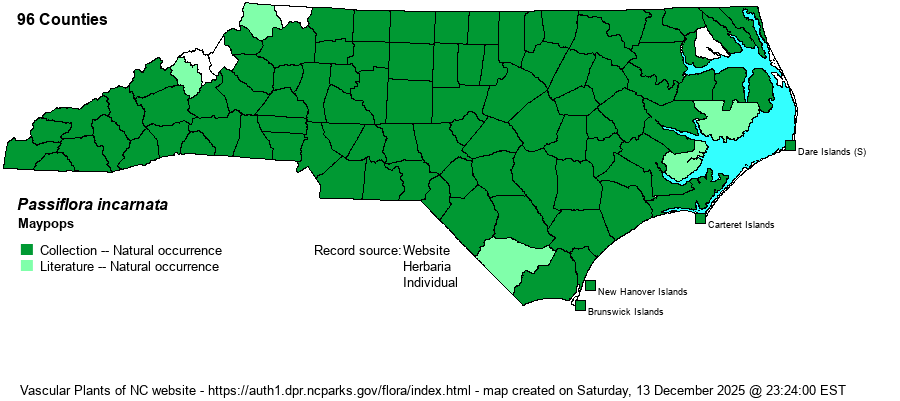| Author | L. | |
| Distribution | Statewide, apparently scarce in the northern Mountains and in a few far eastern counties.
This is a Southern species, ranging from DE and eastern KS south to southern FL and central TX.
| |
| Abundance | Common over most of the state, but uncommon in the northern Mountains and far eastern counties, such as along the Outer Banks. | |
| Habitat | This is a species of open or disturbed habitats, being easily found along fencerows, margins of thickets, woodland borders, and old fields. |
| Phenology | Blooms mainly from May to July, and sporadically later; fruits from July to October. | |
| Identification | This is a very familiar and popular native wildflower, known to nearly everyone. It is an herbaceous, climbing or trailing vine that often reaches 20-25 feet long. The alternate leaves are very distinctive, having 3 leaflets and entire margins; each leaflet is about 2 inches long and 3/4-inch wide. The huge and complicated-looking flowers are axillary, opposite a leaf; each has a spread of almost 3 inches across, with white to lavender petals. The corona has numerous thread-like filaments, looking like white and purple strings coming off the center of the flower; see photos for a better understanding of the flower structure. The fleshy green fruit is about 2 inches long, ovoid in shape, and edible to humans. This species is a valuable host plant for several showy butterflies, such as Gulf and Variegated fritillaries, and Zebra Longwings farther south. | |
| Taxonomic Comments | None
| |
| Other Common Name(s) | Purple Passionflower, Passion-vine | |
| State Rank | S5 | |
| Global Rank | G5 | |
| State Status | | |
| US Status | | |
| USACE-agcp | | |
| USACE-emp | | |

